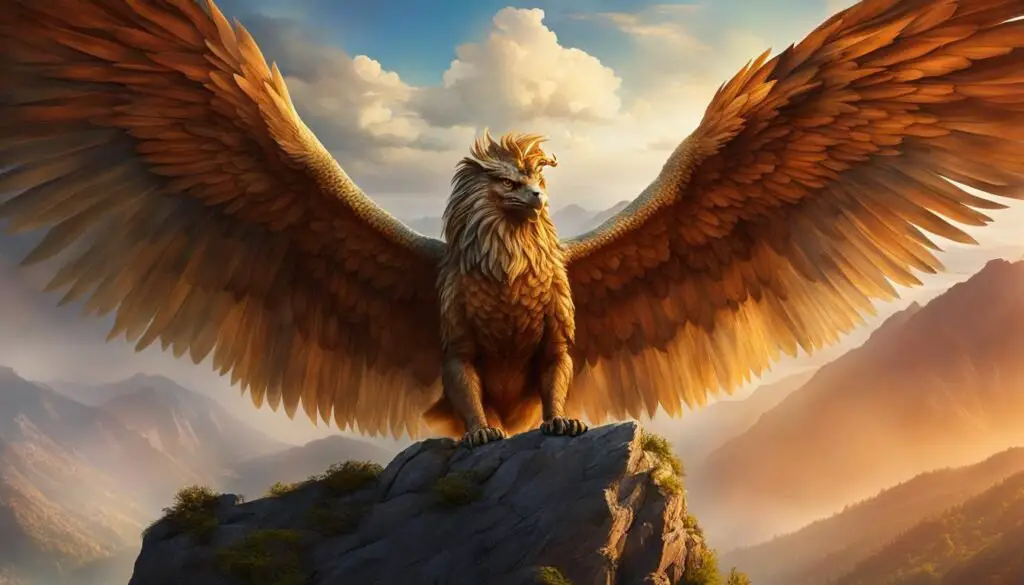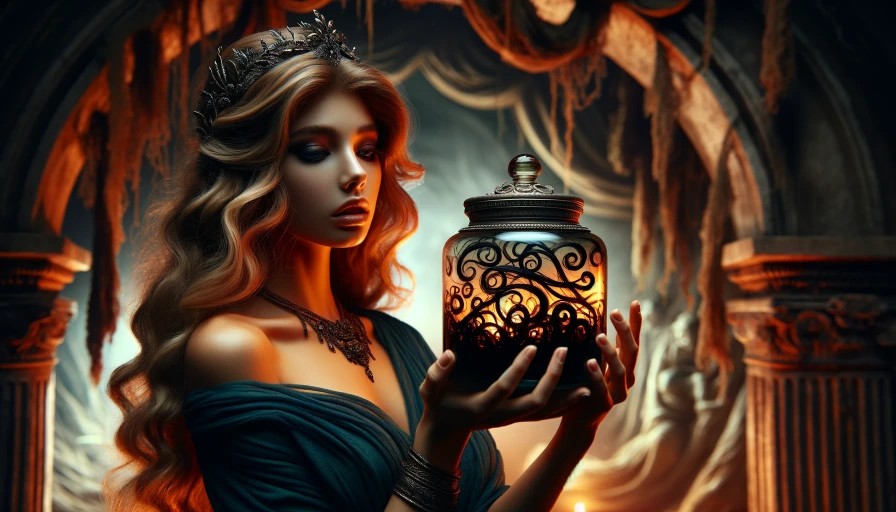Welcome to our exploration of the griffin, a mythical creature with a rich history in Greek mythology. Known as a legendary hybrid, the griffin is a fascinating combination of a lion and an eagle, with the body of a lion and the head and wings of an eagle. In ancient Greece, these powerful beasts were revered and admired for their role as guardian creatures, symbolizing strength, protection, and majesty.
Key Takeaways:
- The griffin is a unique and powerful hybrid creature from Greek mythology.
- It is half lion and half eagle, symbolizing strength, protection, and majesty.
- Griffins are known for their role as guardian creatures in ancient Greece.
- They are considered mythological animals and have a significant place in folklore.
- The griffin represents the connection between the human world and the realm of mythical creatures.
Origins and History of Griffin Mythology
The origins of griffin mythology are shrouded in mystery, with theories suggesting influences from the Near East or India. These legendary creatures, known for their distinctive features of a lion’s body and an eagle’s head, were believed to inhabit the Scythian mountains of Central Asia, guarding valuable gold deposits, according to ancient Greek and Roman texts.
Griffins held a significant presence in ancient civilizations, symbolizing treasure and abundance. They were revered for their majestic forms and feared for their powerful guardianship. The allure of these mythical creatures extended far and wide, captivating people’s imagination and leaving a lasting impact on various cultures.
It is believed that griffins, with their connection to gold deposits and their role as powerful protectors, played a vital part in shaping the narratives of ancient tales and legends. Their presence in mythology continues to captivate and inspire, instilling a sense of awe and wonder in those who encounter their stories.
Theories and Legends
The origins of griffins have been subjects of speculation and debate among scholars. Some propose that the influence of griffins in ancient Greek mythology may have come from the Near East, where similar hybrid creatures were depicted in artwork and literature.
Another theory suggests an Indian origin for griffins, drawing connections to mythical creatures found in Indian folklore. This theory suggests that the concept of griffins may have spread to ancient Greece through trade and cultural interactions.
Regardless of their exact origins, griffins’ association with gold deposits and guardianship exemplifies their significance and the widespread belief in their power and existence. Their rich history in ancient civilizations adds to their allure and fascination even today.
Throughout history, these mythical creatures have been depicted in various forms of art, literature, and architecture, adding to their cultural influence and symbolism. The image above illustrates the mythical allure of griffins in their association with gold deposits in the Scythian mountains.
Symbolism and Significance of Griffins in Ancient Greece
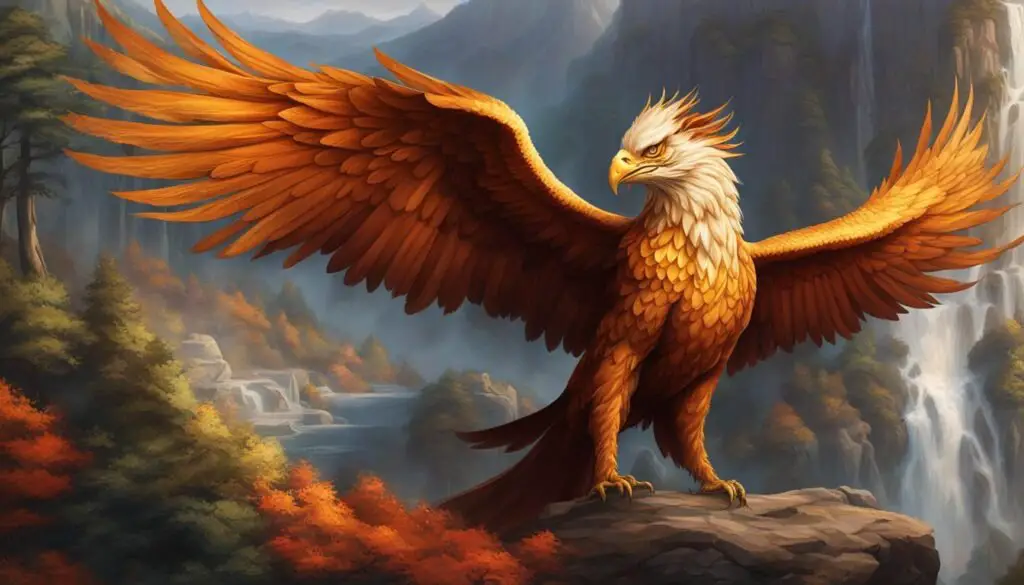
In ancient Greek culture, griffins held great symbolism and significance. These divine creatures were seen as powerful guardians, representing strength, majesty, and guardianship. The connection between humans, gods, and mythical creatures was exemplified by the presence of griffins, showcasing their important role in ancient Greek society.
The symbolism of griffins extended beyond their physical form. With the body of a lion and the head and wings of an eagle, they embodied the combined strength and grace of both land and sky. Their majestic presence served as a reminder of the divine forces at play, bridging the gap between the mortal world and the realm of gods.
Guardianship was a defining trait of griffins, making them highly revered and sought after for their protective qualities. It was believed that these mythical creatures possessed the strength and vigilance to ward off any threat, ensuring the safety and well-being of those they watched over. Their role as protectors extended beyond physical dangers to include the safeguarding of treasures and even golden deposits.
The significance of griffins in ancient Greek society went beyond their practical utility. They were also seen as a symbol of power, serving as a visual representation of the strength and courage that individuals aspired to possess. Their presence in artwork, literature, and architectural decorations showcased their role as an inspiration for human endeavor.
Griffins represented the harmonious connection between humanity and the divine. Through their symbolism and majesty, they reminded the ancient Greeks of the interconnectedness of the earthly and celestial realms. Their portrayal in various artistic mediums and their continued significance in contemporary culture serve as a testament to their enduring legacy and the lasting impact they have had on our collective imagination.
Key Points:
- Griffins held great symbolism and significance in ancient Greek culture
- They represented strength, majesty, and guardianship
- Griffins bridged the gap between humans, gods, and mythical creatures
- They were revered for their protective qualities and guarding abilities
- Griffins symbolized power, inspiring individuals to strive for courage and strength
Different Depictions and Descriptions of Griffins in Art and Literature

Griffins have long been a captivating subject in ancient Greek art and literature. From exquisite bronze utensils to intricate ceramics and even elaborate armor, these powerful and majestic creatures were immortalized by renowned artists. Their depictions showcased the grandeur and awe-inspiring qualities of these half-lion, half-eagle beings.
Ancient Greek temples adorned with magnificent griffin sculptures and reliefs further showcased their importance in the culture. These temple decorations captured the essence of the griffin’s powerful and majestic presence, symbolizing their role as guardians and protectors.
Descriptions of griffins vary among classical writers, each bringing their own unique perspective to the mythical creature. Some focused on the griffin’s awe-inspiring wings, highlighting their ability to soar through the skies with grace and power. Others paid attention to the intricate details of their ears, which were believed to possess heightened senses and intelligence.
One fascinating description mentions the griffin’s unique ability to deposit agate stones among their eggs. This intriguing characteristic added to the mythical aura surrounding these legendary creatures, leaving room for plenty of interpretations and variations in descriptions.
Allow yourself to explore the rich tapestry of depictions and descriptions of griffins in ancient Greek art and literature, and uncover the awe-inspiring qualities that have captured the imagination of artists and enthusiasts throughout history.
Key points:
- Ancient Greek art showcases various depictions of griffins in different forms, including bronze utensils, ceramics, and armor.
- Renowned artists emphasized the powerful and majestic qualities of griffins in their works.
- Temple decorations adorned with griffin sculptures and reliefs highlighted their role as guardians and protectors.
- Classical writers provided varied descriptions of griffins, focusing on attributes like wings, ears, and unique abilities.
Griffin Tattoo Meaning
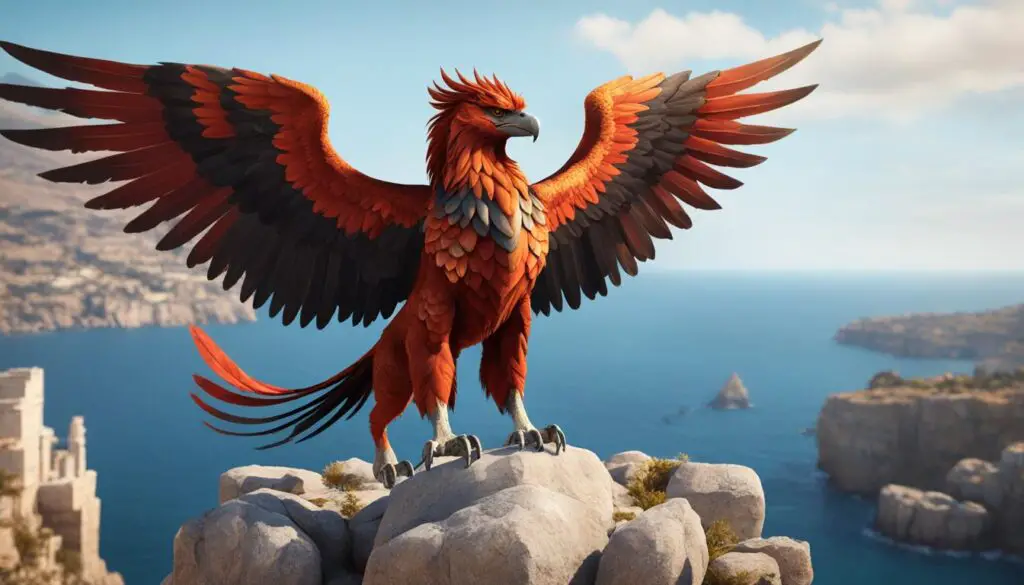
Griffin tattoos have soared in popularity, capturing the fascination of tattoo enthusiasts worldwide. These intricate designs hold deep symbolism and a profound connection to Greek mythology and the ancient world, making them artistic masterpieces of both history and mythical creatures.
Griffins symbolize strength, courage, and wisdom, embodying the qualities of powerful protectors. Just as these majestic creatures were revered as guardians in Greek mythology, representing a bridge between humans and divine entities, griffin tattoos express a sense of fortitude and bravery.
By choosing a griffin tattoo, individuals showcase their values and beliefs, celebrating the courage and resilience needed to navigate life’s challenges. These tattoos serve as a reminder to tap into their inner strength, enabling them to overcome any hurdles they encounter.
The Symbolism of Griffin Tattoos:
- Protectors: Griffin tattoos signify protection, acting as a shield against adversity and external threats.
- Strength: The lion’s body in the griffin represents physical strength, not only in the mythological beast but also in the person who bears the tattoo.
- Courage: As an amalgamation of an eagle, griffin tattoos evoke qualities of bravery and fearlessness, inspiring individuals to face challenges head-on.
- Wisdom: The wisdom attributed to the griffin emphasizes the importance of making informed decisions and seeking knowledge.
- Connection to Greek Mythology: Griffin tattoos honor the rich heritage of Greek mythology, preserving the tales and fascination with this legendary creature.
Whether displayed on the shoulder, arm, or back, griffin tattoos are a testament to the wearer’s appreciation for history, art, and the human spirit. These mythical creations not only manifest as stunning works of body art but also serve as a source of inspiration, reminding individuals of their inner power and the courage they possess.
Griffin Mythical Creature
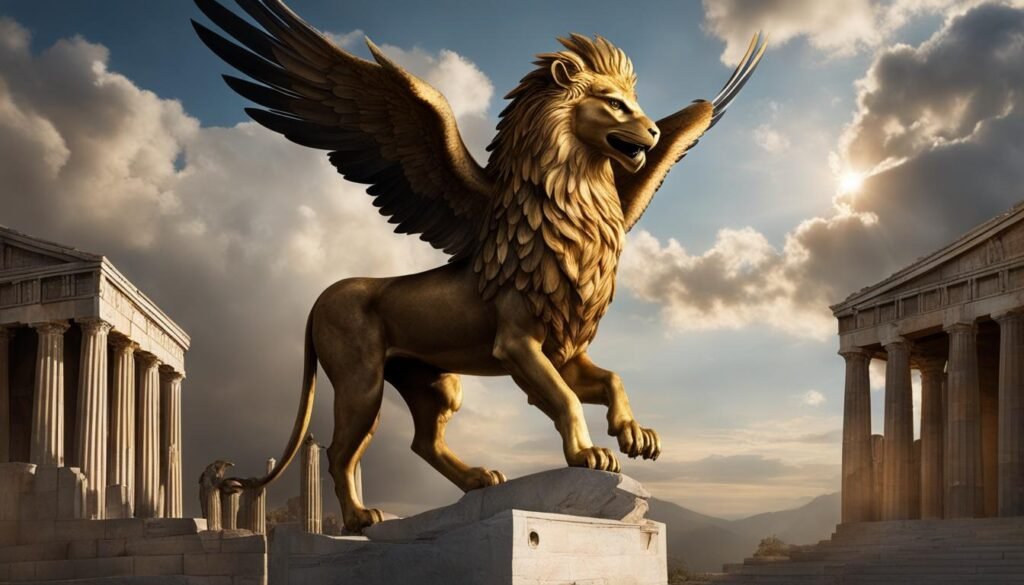
Griffins are extraordinary creatures that hold a prominent place in mythology. With a unique combination of a lion’s body and an eagle’s head, they embody the qualities of strength, intelligence, and vigilance.
In ancient lore, griffins were often depicted as guardians of golden deposits, fiercely protecting these treasures from those who sought to seize them. These majestic creatures engaged in legendary battles as they defended their precious holdings with unwavering determination.
With their powerful wings and keen senses, griffins bridged the realms of earthly and divine, embodying the best of both land and sky. Their hybrid nature made them formidable and revered beings in the mythological world.
The Griffin’s presence in mythology represents the enduring fascination humans have with hybrid creatures and their ability to transcend natural boundaries.
Conclusion
The legacy of the griffin in Greek mythology is a captivating tale that has fascinated artists, writers, and historians throughout history. These mythical creatures hold great symbolism and significance in ancient Greece, representing the profound connection between humans, gods, and mythical beings. Their presence in ancient art and literature showcases their enduring cultural influence and the power they held in the collective imagination of the ancient world.
From ancient Greek depictions to modern tattoo art, the griffin continues to inspire and intrigue with its powerful presence and legendary qualities. The griffin’s legacy lives on through ancient tales and the symbolism it embodies. As guardians and protectors, they embody strength, courage, and wisdom, reminding us of the virtues admired by ancient societies.
Through its symbolism and cultural influence, the griffin has left an indelible mark on human imagination and artistic expression. It serves as a bridge between the mortal and divine realms, illustrating the rich folklore and mythology that has shaped our understanding of the ancient world. The griffin’s legacy endures, continuing to enchant and inspire generations to come.
FAQ
What is a griffin in Greek mythology?
A griffin is a mythical creature that is half lion and half eagle. It is a legendary hybrid known for its strength and majesty, often depicted as a guardian creature in ancient Greece.
Where did the mythology of griffins originate from?
The origins of griffin mythology are uncertain, with theories suggesting influences from the Near East or India. Greek and Roman texts suggest that griffins were believed to guard gold deposits in the Scythian mountains of Central Asia.
What is the symbolism and significance of griffins in ancient Greece?
Griffins held great symbolism and significance in ancient Greek culture. They were associated with divine creatures and represented strength, majesty, and guardianship. Their presence highlighted the importance of their role in ancient Greek society.
How were griffins depicted in ancient Greek art and literature?
Griffins were depicted in various forms such as bronze utensils, ceramics, and even armor. Renowned artists showcased their powerful and majestic qualities in paintings and temple decorations. Descriptions of griffins varied among classical writers, with some focusing on their wings, ears, and unique abilities.
What does a griffin tattoo symbolize?
Griffin tattoos often symbolize strength, courage, and wisdom. They are seen as powerful protectors and represent a connection to Greek mythology and the ancient world.
What are the characteristics of a griffin in mythology?
A griffin is a mythical creature with the body of a lion and the head and wings of an eagle. It is known for its strength, intelligence, and vigilance. In mythology, griffins are often associated with guarding golden deposits and engaging in legendary battles.


